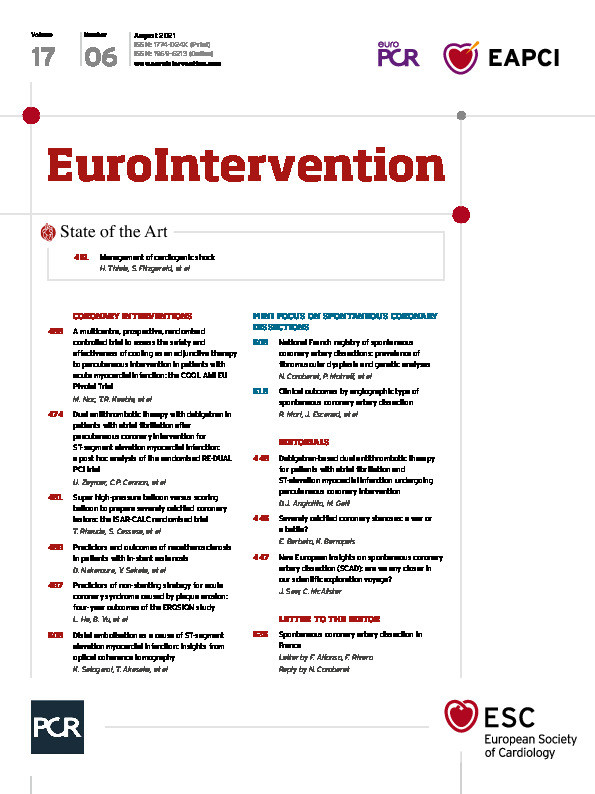The saga of the optimal antithrombotic therapy to be used among patients with atrial fibrillation (AF) undergoing percutaneous coronary interventions (PCI) has been highly interwoven, with recommendations changing significantly over the last decade1. The current consensus is that, after a short course of triple therapy (e.g., up to one week), the default strategy should be early initiation of dual antithrombotic therapy with a novel oral anticoagulant plus a P2Y12 inhibitor, preferably clopidogrel (i.e., discontinue aspirin)2,3. While a dual antithrombotic strategy has consistently been shown to be associated with reduced bleeding, some meta-analyses have suggested that this may expose patients to an increased risk of stent thrombosis (ST), which, however, remains a rare event4. Accordingly, an extended duration of triple therapy (i.e., up to one month) can be considered for patients at high thrombotic and low bleeding risk2,3.
Patients with an acute coronary syndrome (ACS), particularly those with ST-elevation myocardial infarction (STEMI), represent the extreme expression of thrombotic risk, calling into question whether an early initiation of dual antithrombotic therapy can be safely implemented in these patients. This topic is now addressed in a subgroup analysis of the RE-DUAL PCI trial5.
Briefly, RE-DUAL PCI randomised AF patients undergoing PCI (~50% with ACS) to vitamin K antagonist (VKA)-based triple therapy lasting on average 2.7 months (n=948), or dual therapy with dabigatran 110 mg/bid (n=972) or 150 mg/bid (n=758)6. The mean time from PCI to randomisation was 1.6 days. Compared to triple therapy, dual therapy was associated with a reduction of the primary safety endpoint without any trade-off in the composite efficacy endpoint. However, compared with triple therapy, there was a numerical increase in myocardial infarction (MI) and ST with dual therapy using dabigatran 110 mg/bid, but not dabigatran 150 mg/bid, a finding that was heightened in the subgroup of patients with ACS7.
In this edition of EuroIntervention, Zeymer et al further expand on these findings by comparing outcomes of patients with STEMI (n=305; 11.2%) versus patients who had a PCI for non-ST-elevation MI (NSTEMI), unstable angina or who underwent an elective PCI (n=2,393; 87.8%). Both dabigatran doses reduced the primary bleeding endpoint with a non-significant increase in the composite ischaemic endpoint with dabigatran 110 mg/bid (HR 1.61, 95% CI: 0.85-3.08) but not with dabigatran 150 mg/bid (HR 0.56, 95% CI: 0.20-1.51), albeit without a significant p-interaction for subgroup differences5. The authors should be commended for providing the first report in a subgroup of STEMI patients with AF undergoing PCI. However, there are several considerations to be made when interpreting the results from this analysis. First, STEMI patients were compared to NSTEMI/unstable angina/stable patients. Although STEMI patients are at increased risk for thrombotic events, this is also true for NSTEMI, potentially masking any differences between the compared cohorts. Indeed, the overall risk of the composite ischaemic endpoint was higher for STEMI and NSTEMI (14.8% and 17.9%, respectively) and lower for unstable angina and elective PCI (10.8% and 12.4%, respectively) patients. Second, the two cohorts are largely unbalanced both in size (305 vs 2,393 patients) and in key baseline characteristics, such as the use of ticagrelor in the dual therapy group among STEMI patients (26.3% vs 9.8%). Such unbalances could have led to an overestimation of bleeding and an underestimation of ischaemic outcomes between cohorts, especially in the subgroup of dabigatran 110 mg/bid in which ticagrelor was found to attenuate the excess of ischaemic events7. Third, subgroup analyses were underpowered for thrombotic complications. Thus, p-values should be interpreted with caution. The numerical increase of thrombotic events observed among STEMI patients in the dual therapy arm with dabigatran 110 mg/bid (21.2%) compared to triple therapy (14.2%) and dual therapy with dabigatran 150 mg/bid (7.0%) indeed merits clinical attention.
In conclusion, this study represents another important contribution in support of the use of dabigatran-based dual therapy among AF patients undergoing PCI. The RE-DUAL PCI trial showed a marked reduction of bleeding with dabigatran-based dual therapy regimens compared to triple therapy, irrespective of clinical presentation. However, in patients at high thrombotic risk such as those with an ACS, including STEMI, while there was no trade-off in ischaemic events with dabigatran used at a dosage of 150 mg/bid, there are concerns on the antithrombotic efficacy associated with the use of the 110 mg/bid regimen as part of an early dual therapy strategy. Indeed, this is further compounded if associated with the use of clopidogrel, which is characterised by broad interindividual response variability with a considerable number of patients, particularly those at high thrombotic risk, with inadequate antiplatelet effects. Ongoing investigations (NCT03234114) will provide important insights on the safety and efficacy of clopidogrel versus ticagrelor in addition to dabigatran 110 mg/bid as part of a dual therapy strategy among AF/ACS patients undergoing PCI.
Conflict of interest statement
D.J. Angiolillo reports receiving payments as an individual for: a) consulting fees or honoraria from Abbott, Amgen, Aralez, AstraZeneca, Bayer, Biosensors, Boehringer Ingelheim, Bristol-Myers Squibb, Chiesi, Daiichi Sankyo, Eli Lilly, Haemonetics, Janssen, Merck, PhaseBio, PLx Pharma, Pfizer, Sanofi, and The Medicines Company; b) participation in review activities from CeloNova and St. Jude Medical. He also reports institutional payments for grants from Amgen, AstraZeneca, Bayer, Biosensors, CeloNova, CSL Behring, Daiichi Sankyo, Eisai, Eli Lilly, Gilead, Idorsia, Janssen, Matsutani Chemical Industry Co., Merck, Novartis, Osprey Medical, Renal Guard Solutions and the Scott R. MacKenzie Foundation. The other author has no conflicts of interest to declare.
Supplementary data
To read the full content of this article, please download the PDF.

